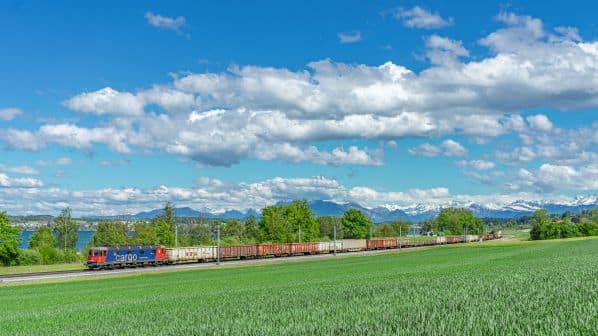AS Europe works towards a 90% reduction in greenhouse gas emissions from transport by 2050, the future of rail freight and all its many facets are being intensively discussed in Switzerland. The Federal Office of Transport (OFT) is currently consulting all stakeholders and will present its final proposals to the Swiss Parliament and the Federal Council later this year.
This provides us with an opportunity to consider in particular the future of single wagonload (SWL) traffic in Europe, requiring a brief analysis of the current situation. Why is SWL having such a hard time today? Firstly, governments have focused on intermodal, which is almost exclusively the only kind of rail freight mentioned in many political discussions and proposals for achieving modal shift, including its associated terminals.
In addition, there is no on-rail competition for SWL. If this service is provided at all, it is operated by state-owned companies and hence supported with enormous public subsidy. This has been the case for several decades, with the consequence that the pressure to improve and innovate is rather low. And customer focus tends not be the main concern of state-owned freight operators, which are more concerned with their production processes, leading to a lack of concern for the current and future needs of their customers.
There is also lack of integration between the member states of the European Union (EU), no single overview that brings together the capacity requirements in terms of train paths, sidings and transhipment facilities that are needed to produce an overall transport concept. Some initiatives in this respect are ongoing, such as Timetable Redesign (TTR) which has now been in progress for some years or the Rail Facility Portal (RFP), which has not yet reached the required level of quality. The overall transport concept must also apply to land use planning, as shifting freight from road will require new rail-served terminals.
To determine the way ahead for rail freight and SWL in particular, we must start with a transparent and open analysis of the current situation and recognise that rail freight is mainly funded with public money. This model is not sustainable and cannot be relied upon to continue in the future.
Any discussion of the future of rail freight must be based on facts. We need to know what performance in terms of security of supply, flexibility, sustainability and, in particular, self-sufficiency will be needed to meet the requirements of the freight market in 2050.
Ecological and economic considerations will also influence the choice of mode of transport or freight product, but there must be no conflict between rail and road or between players within the rail sector. Customers must be able to choose the best means of transport for moving their goods. Wisely combined, all modes together ensure a functioning economy and supply chain, with rail ideally suited to delivering large quantities to a fixed number of locations. Particularly for consumer products, lorries and other road vehicles can provide highly flexible service within a given area with door-to-door delivery.
As the users of this multimodal network, freight customers want to see the creation of sustainable frameworks for all modes of transport according to their strengths, enabling them to rely on multimodal logistics chains that function efficiently with many different players and providers. A sustainable, digital information platform should offer multimodal supply options. In the rail sector, better use needs to be made of existing resources such as train paths, rolling stock and personnel. State-owned operators will also have a new role as important partners and traction providers.
If rail freight wants to play a significant role in achieving the 2050 climate goals, the attitudes of the stakeholders involved need to change.
In order for these aspirations to become reality, and for SWL to have a future, solid foundations need to be built on a unified understanding between all parties. They must think in terms of all modes, combining different infrastructure and operators to provide an efficient logistics solution, which is especially important for optimum infrastructure use and for reducing CO2 emissions. Combining different modes makes supply chains less vulnerable, as unforeseen events in the past have shown that no mode of transport can be neglected or considered in isolation. Planned or unplanned line closures, extreme weather events and strikes can interrupt logistics flows, making it all the more important to find alternatives that minimise environmental impact and maximise economic efficiency.
There is also a need to implement data ecosystems as a whole. The rail freight sector is in great need of more digitalisation, not only within railway companies but across all parties including customers. At present, there is a lack of transparent, relevant and readily-available information, although greater progress has already been made here in the road and intermodal sectors, because of the more competitive market environment.
To meet this challenge, an open and intelligent data platform should be introduced for freight transport as a whole. There are promising initiatives in Europe. In Switzerland, the OFT is currently working on a new regulation for passenger transport, which considers the provision of mobility data infrastructure, and efforts are underway to include freight.

The rail freight sector also needs to embrace the principle of “coopetition”, which sees rival companies collaborating with one another in a combination of cooperation and competition. It influences the actions of market players without them explicitly cooperating. In the rail freight sector, this could see targeted cooperation at the same level of value creation or horizontal cooperation. Different shippers or operators with similar low volumes on comparable routes could bundle this traffic, while operators on other routes would still compete with each other. In this way, coopetition could significantly stimulate competition in the use of resources such as wagons, transhipment facilities, sidings or overlapping routes. Similar approaches have been followed for some time in other modes, such as aviation.
Some redefinition of roles is required. It may be understandable from a business perspective that some companies are looking to increase their influence in rail freight, but this does not help to optimise the system as a whole in terms of customer benefits nor increase rail’s share of multimodal logistics chains. We need a rail freight system in which each market player takes on tasks, competencies and responsibilities according to their strengths. In this context, operators retain their important function as traction providers, especially for serving the last mile.
Tackling poor viability
The biggest argument for subsidising SWL is its apparent lack of economic viability. However, it has rarely been asked how the system can be fundamentally changed, with state-owned operators avoiding an open discussion of the issue in order to prevent any diminishing of their influence.
Within the framework of a complete redesign of all processes, including production (such as the number and quality of shunting services), incentive instruments, market mechanisms and interfaces within multimodal freight logistics, SWL must be made fit for the future. The goal must be a self-sustaining and market-based system that includes all freight operators without discrimination on the basis of intramodal competition and that is reliably available to all shippers.
Last-mile operations must be entrusted to a company that is legally independent, in the overriding interest of security of supply and to reposition rail freight within multimodal logistics. This reduces the fixed costs of the current operators, largely state-owned, and allows them to concentrate on their strengths. Costs that are currently fixed must be made variable. Many operators have a large and diverse rolling stock fleet due to their long history, which means high operating and maintenance costs. Other companies lease these assets over a fixed term or use options such as sale and leaseback.
If not done already, track access charges for freight need to be reduced quickly. This measure has an immediate benefit for all operators and is fairer. The current level of charges is too high in relation to the service provided, especially given the priority usually given to passenger trains by infrastructure managers and the current proliferation of uncoordinated line closures for maintenance and upgrade work.
Rail freight needs innovation, and the Digital Automatic Coupler (DAC) will play a central role in bringing it into a new age. However, the focus must not be on the technical component on the wagon, but on the digital world that it enables in which rail freight will be revolutionised.
The DAC is a precondition for SWL operation on routes where ETCS Level 3 will be installed in the future. Our focus must therefore be even more on the new processes and opportunities offered by digitalisation and better connectivity between all players. These are the real challenges and the biggest opportunities of the DAC project.
When operators are no longer involved in epic debates about train integrity and tail lights, no longer have to undertake complicated brake testing beyond what is required by the operating regulations, and when trains can depart promptly once loading has been completed, then rail freight will have taken a great leap forward. In addition, if the shipper, end customer, subsequent service providers and plant stock control managers can see online where consignments are, whether they are still correctly loaded, if they are travelling at the correct temperature, and know exactly when the goods will arrive, then rail freight will form part of today’s logistics world. What we have all been seeing in the road haulage industry for the last 15 years is finally also becoming reality in rail.
That is why it is so urgent to roll out DAC, and why this programme should be provided with sufficient funding and supported by all stakeholders. However, this opportunity should also be taken to raise the entire rail freight system to a new level, such as using digital freight trains to provide as yet undefined data or instilling the political will at national level to deal more thoroughly and seriously with the topic of freight transport.
A thriving economy and prosperity depend on functioning logistics. In recent decades, there have been numerous initiatives at both the international and national level to promote rail freight. Unfortunately, the result has often been only declarations of intent or well-intentioned approaches that have only been applied in a narrow field. Initiatives such as Horizon 2020, the Connecting Europe Facility (CEF), Shift2Rail or its successor the Europe’s Rail joint research undertaking, have all provided a great deal of money for innovation, but widescale implementation, major benefits and a major shift to rail have often failed to materialise.
There are many - both understandable and incomprehensible - reasons for the current situation in rail freight. However, if rail freight wants to play a significant role in achieving the 2050 climate goals, the attitudes of the stakeholders involved need to change. Rail freight and logistics are vital to the economy and society. Accordingly, at the political level, sufficient funding must be provided, especially on the national level in the manner of the Railway Infrastructure Fund in Switzerland. Spatial planning must take rail freight’s needs into consideration and governments should rethink their relationship with state-owned freight operators.
For other stakeholders, it is not always about securing or expanding their own influence, which is understandable for economic reasons, but more about a secure future and the development of the overall system, so that in the end everyone is happy with their slice of the cake and customers are convinced that they are getting value from the service provided. SWL does have a chance and a future, but only with all parties working together actively to bring about fundamental change.
*Jürgen Maier-Gyomlay is owner of the Swiss consultancy Mobility Advisors.

